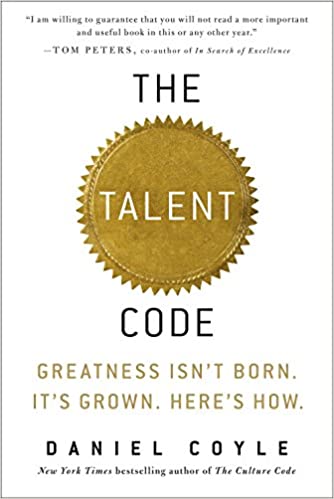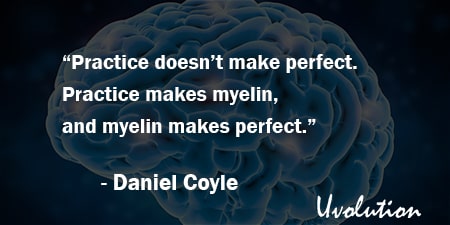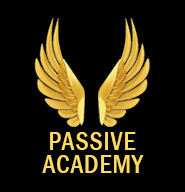The Talent Code by Daniel Coyle
The Book in 1 Sentences
The Talent Code: Greatness Isn't Born. It's Grown. Here's How
“The idea that all skills grow by the same cellular mechanism seems strange and surprising because the skills are so dazzlingly varied. But then again, all of this planet’s variety is built from shared, adaptive mechanism; evolution could have it no other way.
Redwoods differ from roses but both grow through photosynthesis. Elephants differ from amoebas but both use the same cellular mechanism to convert food into energy.
Tennis players, singers, and painters don’t seem to have much in common but they all get better by gradually improving timing and speed and accuracy, by honing neural circuitry, by obeying the rules of the talent code— in short, by growing more myelin.” ~ Daniel Coyle
5 BIG Ideas
1. It’s all about myelin!
2. Myelin is just like muscle, needs deep practice.
3. Greatness isn’t born. It’s grown.
4. Baby steps are the royal road to skill.
5. The Talent Code = Deep practice + Ignition (a vision of what’s possible) + Teacher (help us to re-wire our brains with myelin)
The Talent Code Summary
1. Myelin
“The talent code is built on a revolutionary scientific discovery involving a neural insulator called myelin, which some neurologists now consider to be the holy grail of acquiring skill. Here’s why.
Every human skill, whether it’s playing baseball or playing Bach, is created by chains of nerve fibers carrying a tiny electrical impulse—basically, a signal traveling through a circuit.
Myelin’s vital role is to wrap those nerve fibers the same way that rubber insulation wraps a copper wire, making the signal stronger and faster by preventing the electrical impulses from leaking out.
When we fire our circuits the right way—when we practice swinging that bat or playing that note—our myelin responds by wrapping layers of insulation around the neural circuit, each new layer adding a bit more skill and speed.
The thicker the myelin gets, the better it insulates, and the faster and more accurate our movements and thoughts become.”
“To sum up: it’s time to rewrite the maxim that practice makes perfect. The truth is, practice makes myelin, and myelin makes perfect.”
Myelin is the secret to greatness!
2. Deep practice
“Deep practice is built on a paradox: struggling in certain targeted ways—operating at the edges of your ability, where you make mistakes—makes you smarter.
Or to put it a slightly different way, experiences where you’re forced to slow down, make errors, and correct them—as you would if you were walking up an ice-covered hill, slipping and stumbling as you go—end up making you swift and graceful without you realizing it.”
We grow and flourish when we challenge our abilities and go beyond our comfort zone!
“Q: Why is targeted, mistake-focused practice so effective?
A: Because the best way to build a good circuit is to fire it, attend to mistakes, then fire it again, over and over. Struggle is not an option. It’s a biological requirement.
Q: Why are passion and persistence key ingredients of talent?
A: Because wrapping myelin around a big circuit requires energy and time. If you don’t love it, you’ll never work hard enough to be great.
Q: What’s the best way to get to Carnegie Hall?
A: Go straight down Myelin Street.”
“As Dr. George Bartzokis, a UCLA neurologist and myelin researcher, put it: “All skills, all language, all musical, all movements, are made of living circuits, and all circuits grow according to certain rules.””
3. Myelin and Muscles!
“On one level, the study of myelin sounds like an exotic new neuroscience. But on another level, myelin is similar to another evolution-built mechanism you use every day: muscles.
If you use your muscles a certain way—by trying hard to lift things you can barely lift—those muscles will respond by getting stronger. If you fire your skill circuits the right way—by trying hard to do things you can barely do, in deep practice—then your skill circuits will respond by getting faster and more fluent.”
You train your muscles, it gets way stronger…
You practice deeply, challenge your ability, be persistent… your skill circuits will respond by getting faster and more fluent!
Got this?!
It’s the training effect.
“Skill is insulation that wraps neural circuits and grows according to certain signals.”
4. Cosmic Dice!
“For the last few hundred years, Western culture has understood and explained talent using the idea of unique identity—the tumble of cosmic dice that makes everyone different, and a few lucky people special.
According to that way of thinking, the Brontës and the Z-Boys succeeded because they were exceptional—mysteriously gifted outsiders, destiny-kissed Kids from Nowhere.
Seen through the lens of deep practice, however, the story flips. Uniqueness still matters, but its significance resides in the way the Brontës and the Z-Boys do the things necessary to build their remarkable skills: firing the right signals, honing circuits, making tiny books and filling them with childish stories, searching out empty swimming pools so that they can spend hours riding and falling inside them.
The truth is, plenty of other Yorkshire girls had lives just as parochial and constricted as the Brontës’, just as plenty of other Los Angeles kids were as edgy and cool as the Z-Boys. But myelin doesn’t care who you are. It only cares about what you do.”
5. Michelangelo
“Consider Michelangelo. From ages six to ten he lived with a stonecutter and his family, learning how to handle a hammer and chisel before he could even write. After a brief, unhappy attempt at schooling, he apprenticed to the great Ghirlandaio.
He worked on blockbuster commissions, sketching, copying, and preparing frescoes in one of Florence’s largest churches. He was then taught by master sculptor Bertoldo and tutored by other luminaries at the home of Lorenzo de’ Medici, where Michelangelo lived until he was seventeen.
He was a promising but little-known artist until he produced the Pietà at age twenty-four. People called the Pietà pure genius, but its creator begged to differ. “If people knew how hard I had to work to gain my mastery,” Michelangelo said, “it would not seem so wonderful at all.””
To reach greatness, it takes time, effort, deliberate practice…. And Myelin!
6. Baby Steps
“Long story short: a few years ago, a group of American and Norwegian researchers did a study to see what made babies improve at walking.
They discovered that the key factor wasn’t height or weight or age or brain development or any other innate trait but rather (surprise!) the amount of time they spent firing their circuits, trying to walk.
However well this finding might support our thesis, its real use is to paint a vivid picture of what deep practice feels like. It’s the feeling, in short, of being a staggering baby, of intensely, clumsily lurching toward a goal and toppling over.
It’s a wobbly, discomfiting sensation that any sensible person would instinctively seek to avoid. Yet the longer the babies remained in that state—the more willing they were to endure it, and to permit themselves to fail—the more myelin they built, and the more skill they earned.
The staggering babies embody the deepest truth about deep practice: to get good, it’s helpful to be willing, even enthusiastic, about being bad. Baby steps are the royal road to skill.”
Dan Millman talks about the same idea in his book, Body Mind Mastery: “If babies held the same tendency toward self-criticism as adults, they might never learn to walk or talk. Can you imagine infants stomping, ‘Aarggh! Screwed up again!’ Fortunately, babies are free of self-criticism. They just keep practicing.”
7. Toyota’s Kaizen
“Thirty years ago Toyota was a middling-size car company. Now it is the world’s largest automaker. Most analysts attribute Toyota’s success to its strategy of kaizen, which is Japanese for “continuous improvement” and which just as easily could be called corporate deep practice.”
The secret is to take baby steps, small and consistent steps for “continuous improvement” (Kaizen)…
Coyle says: “It turns out that self-discipline was twice as accurate as IQ in predicting the students’ grade-point average.”
8. Ignition
Coyle tells the story of Roger Bannister—the “skinny Oxford medical student” who, in 1954, became the first person to run a mile in less than four minutes.
He accomplished what Sports Illustrated described as the single greatest athletic accomplishment of the 20th century as most physiologists and athletes thought that was impossible to accomplish!
Coyle continues: “Less well known is what happened in the weeks after Bannister’s feat: another runner, an Australian named John Landy, also broke the four-minute barrier.
The next season a few more runners did too. Then they started breaking it in droves. Within three years no fewer than seventeen runners had matched the greatest sporting accomplishment of the twentieth century.
Nothing profound had changed. The track surfaces were the same, the genes were the same. To chalk it up to self-belief or positive thinking misses the point.
The change didn’t come from inside the athletes: they were responding to something outside them. The seventeen runners had received a clear signal—you can do this too—and the four-minute mark, once an insurmountable wall, was instantly recast as a stepping stone.”
Coyle says: “Where deep practice is all about staggering baby-steps, ignition is about the set of signals and subconscious forces that create our identity; the moments that lead us to say that is who I want to be.”
He also says: “What ignited the process wasn’t any innate skill or gene. It was a small, ephemeral, yet powerful idea: a vision of their ideal future selves, a vision that oriented, energized, and accelerated progress, and that originated in the outside world.”
9. ACTION
“[Albert] Ellis, who went on to write dozens of books, built a straight-talk, action-oriented approach that challenged the Freudian model of examining childhood experience. “Neurosis is just a high-class word for whining,” he said. “The trouble with most therapy is that it helps you to feel better. But you don’t get better. You have to back it up with action, action, action.””
Coyle tells us that Ellis’s approach, combined with that of Dr. Aaron Beck, became known as cognitive-behaviorial therapy—which we scientifically know is as effective as drugs in reducing anxiety, depression and this stuff.
It’s all about how to train your brain to perform better in any situation and to re-wire it with myelin in all the right places.
So, to recap…
The Talent Code = Deep practice + Ignition (a vision of what’s possible) + Teacher (help us to re-wire our brains with myelin)
That was my QUICK The Talent Code summary. If you’re interested, get your copy. There is a HUGE amount of wisdom and life-changing ideas in this book, and we’ve only touched on a tiny bit of it.
Buy The Book: The Talent Code by Daniel Coyle

GET Blinkist 7 Days FREE Trial
3000+ Book Summaries
(Audio and Text)





